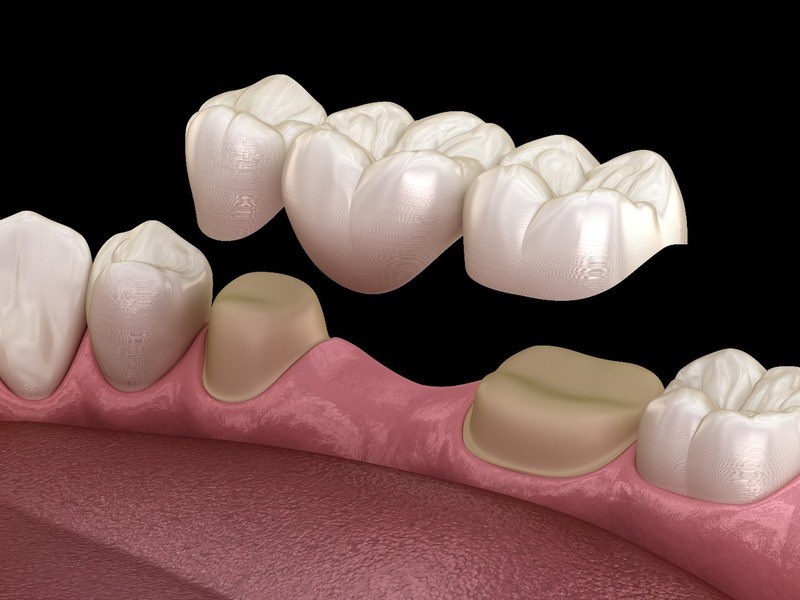
Dental bridges can indeed be replaced when they become worn down, loose, or if you desire an upgrade. These restorations, designed to replace missing teeth, are not permanent and can undergo wear and tear over time. Can dental bridges be replaced? Let us explore the process of replacing dental bridges, the reasons why a replacement may be needed, and what to expect during the procedure.
Dental bridges, like any dental restoration, have a finite lifespan. Factors such as normal wear and tear or changes in the jawbone can lead to issues with the bridge. When you encounter discomfort or have a loose bridge, it’s essential to consult with a dentist. They will assess the condition of the existing bridge and determine if a replacement is necessary. The replacement involves removing the old bridge and crafting a new one to securely fit in its place. Regular dental check-ups and diligent oral hygiene practices are key to prolonging the life of dental bridges. Whether for functional or aesthetic reasons, the option to replace dental bridges is available, ensuring your oral health and satisfaction.

Can Dental Bridges Be Replaced?
Dental Bridge Replacement: Reasons and Process
Reasons for Dental Bridge Replacement:
- Normal Wear and Tear: Over time, dental bridges may exhibit signs of deterioration, such as cracks or chips in artificial teeth or crowns, necessitating replacement.
- Tooth Decay or Damage: Supporting natural teeth may develop cavities or experience trauma, making them unable to support the bridge properly, which may require removal and replacement.
The Replacement Process:
- Removal of Existing Bridge: The existing bridge is removed by carefully cutting and extracting the dental crowns holding it in place.
- Assessment of Natural Teeth: The dentist assesses the condition of natural teeth and supporting tissues to determine the best course of action.
- Creating a New Bridge: If the natural teeth can support a new bridge, impressions are taken to create a precisely fitting replacement. This new bridge is crafted in a dental laboratory and then cemented in place using dental adhesive, requiring multiple dental visits.
- Alternative Treatment Options: If natural teeth are unable to support a new bridge, alternative solutions, such as dental implants or removable partial dentures, may be considered.
Benefits of Dental Bridge Replacement:
- Improved Aesthetics: Replacing a worn or damaged bridge enhances the appearance of the smile, boosting self-confidence and overall facial aesthetics.
- Enhanced Functionality: A well-fitting bridge restores the ability to chew and speak properly, resolving functional issues and allowing for a normal diet and clear speech.
- Prevention of Complications: Promptly replacing a damaged bridge helps prevent potential complications, including tooth decay, gum disease, and jawbone loss, promoting long-term oral health.
Tips for Maintaining Dental Bridges:
- Good Oral Hygiene: Practice regular oral hygiene, including twice-daily brushing, daily flossing, and regular dental check-ups and cleanings.
- Dietary Considerations: Avoid chewing on hard or sticky foods that may damage the bridge.
- Nightguard Use: Wearing a nightguard can protect the bridge from excessive forces caused by teeth grinding or clenching during sleep, reducing premature wear and damage.
In summary, while dental bridges are designed to be durable, replacement may become necessary due to wear and tear, tooth decay, or damage to supporting natural teeth. Prompt replacement offers improved aesthetics, functionality, and oral health. Consistent oral hygiene and protective measures can help extend the lifespan of dental bridges and reduce the need for replacement.
Key Takeaways: Can Dental Bridges Be Replaced?
- Yes, dental bridges can be replaced if they become loose, damaged, or worn out.
- Replacing a dental bridge involves removing the old bridge and creating a new one.
- It is important to visit a dentist regularly to ensure the bridge is in good condition and to address any issues early.
- Proper oral hygiene, such as brushing and flossing, can help prolong the lifespan of a dental bridge.
- Consulting with a dentist is essential to determine the best course of action for replacing a dental bridge.
Frequently Asked Questions
1. How often do dental bridges need to be replaced?
Dental bridges, while durable, require potential replacement. Lifespan hinges on oral hygiene, material quality, and dental check-ups. They typically last 5-15 years, necessitating replacement when loose, fractured, or severely decayed for improved aesthetics and function. Regular dental visits are essential to monitor their condition.
2. What are the signs that a dental bridge needs to be replaced?
There are several signs that indicate a dental bridge may need to be replaced:
– Persistent pain or discomfort around the dental bridge area
– Loose or unstable bridge
– Recurring gum inflammation or infection
– Cracked or fractured bridge
– Significant decay or damage to the supporting teeth
If you experience any of these symptoms, it is important to schedule a dental appointment as soon as possible to assess the condition of your dental bridge and determine if replacement is necessary.
3. Can a broken dental bridge be repaired?
A broken dental bridge can sometimes be repaired, primarily for minor damage like small chips or cracks. Severe breakage usually necessitates a replacement. Consultation with a dental professional is crucial to assess the extent of the damage and determine the suitable action, whether repair or replacement.
4. How long does the process of replacing a dental bridge take?
The process of replacing a dental bridge involves multiple dental visits and may take weeks. The initial visit includes bridge removal and tooth preparation. Custom impressions are taken, and a temporary bridge may be placed. The final appointment includes removing the temporary bridge and cementing the new one after ensuring proper fit and alignment.
5. How much does it cost to replace a dental bridge?
The cost of replacing a dental bridge varies based on location, case complexity, and materials used. Typically, replacement expenses can range from hundreds to thousands of dollars. Consult with a dentist for a detailed, personalized cost estimate, which includes procedure fees, materials, and lab costs.
Why I Don’t Recommend Dental Bridges
Final Thoughts on Dental Bridges Replacement
Dental bridges can be replaced, and recent advancements in dental technology and materials have made the process more efficient and effective. Modern materials can replicate the appearance and strength of natural teeth, ensuring a seamless blend with surrounding teeth. Precise measurements and customizations, aided by advanced techniques and equipment, result in a comfortable and secure fit for the patient.
The decision to replace a dental bridge should always involve consultation with a dental professional. They will assess the existing bridge’s condition, the patient’s oral health, and determine the most appropriate course of action. Patients can confidently explore replacement options with the guidance of these experts to regain a beautiful and functional smile.
Therefore, if you have concerns about your dental bridge, scheduling a visit to your dentist is the best approach to address those concerns and consider replacement options for improved aesthetics and functionality.
Call or Book appointment online
:Ace Dental Care Alpharetta office: 678-562-1555 - Book Now
Ace Dental Care Norcross office: 770-806-1255 - Book Now
Disclaimer
This blog post was generated by artificial intelligence. The content of this post may not be accurate or complete, and should not be relied upon as a substitute for professional advice. If you have any questions about the content of this post, please contact us.
We are constantly working to improve the accuracy and quality of our AI-generated content. However, there may still be errors or inaccuracies. We apologize for any inconvenience this may cause.





